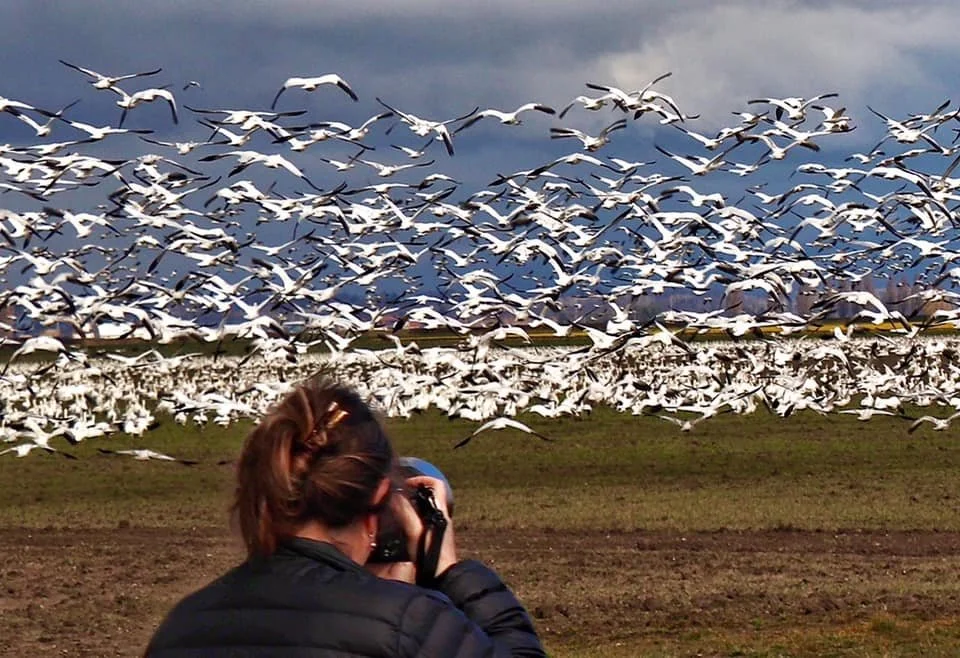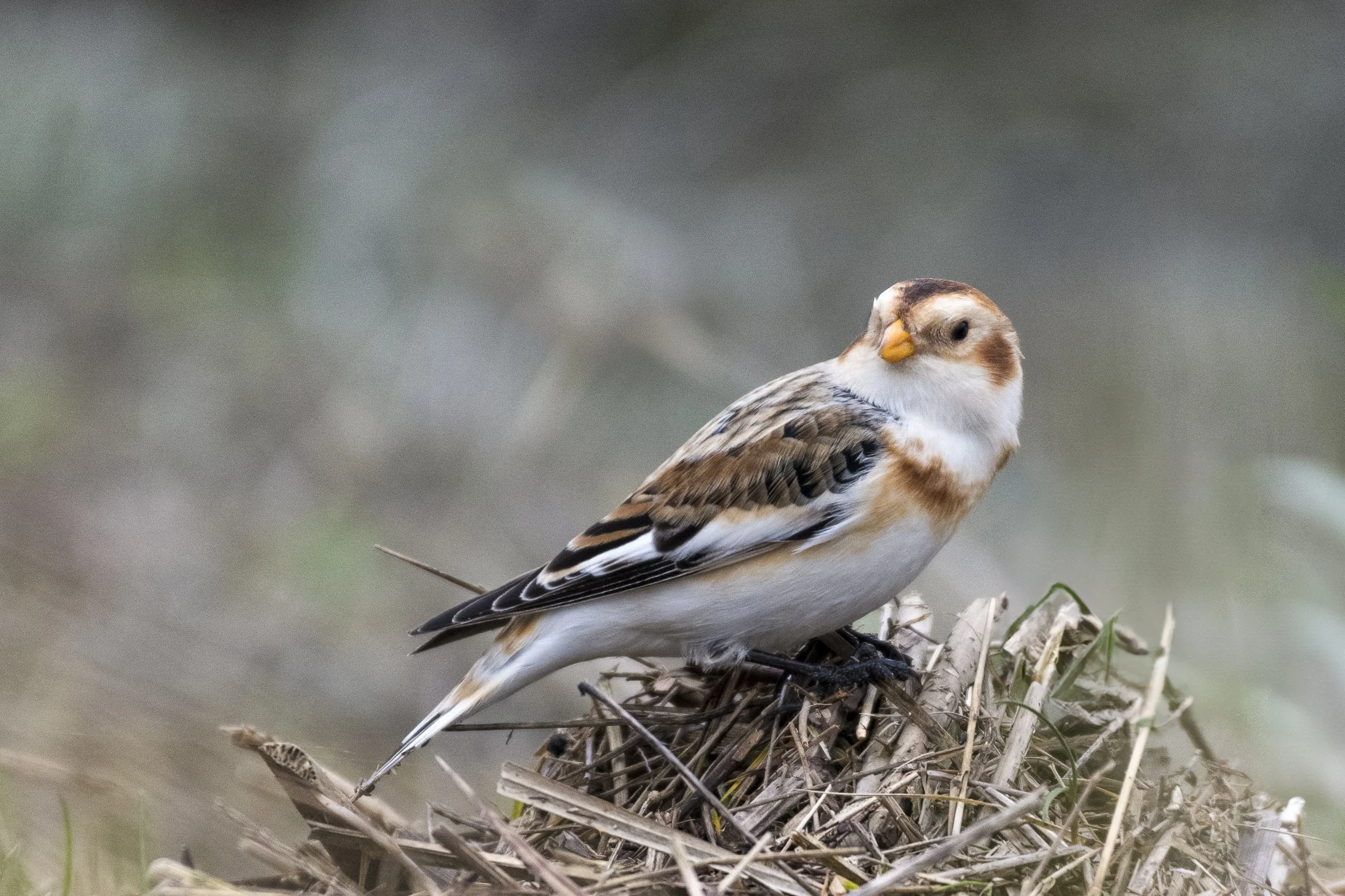Bird Wise Observations: Photographer Nancy Crowell
During the fall and winter birding season we share the testimonials of the different user groups in Skagit whose lives intersect with the wild birds in and on the landscape. This month we are talking to Nancy Crowell, a Skagit-based photographer whose wild bird and landscape images can be seen widely, from the Be Bird Wise and Visit Skagit Valley websites to Biographic Magazine. Nancy’s documentation of Skagit’s wildlife dates from 2008, and her observations span the years since.
Nancy Crowell photographing Snow Geese by Cedarbrook Studio
I was not a birder when I first moved to Skagit in 2000, and would commute across Fir Island on the way and see all those birds! A friend told me what they were. I didn’t know the difference between a snow goose and a trumpeter swan.
I took local raptor authority Bud Anderson’s raptor classes. The Red-tailed hawk is my spark bird. Learning about and seeing the Red-tailed hawk really turned me into a birder.
Photography took off for me in 2008. I had done some photography in my previous life working in media, but that was all on film, and not wildlife-based. This time I invested in digital equipment and started pursuing photography again, inspired by where I now lived.
Kestrel, Crowell Photography
I participated in one particular workshop which inspired my turn to photographing wildlife. I did a workshop in Jackson Hole with professional photographers from National Geographic. That experience more than any other reminded me that there was such an opportunity right here in Skagit.
That workshop also taught me that being able to anticipate the behavior of my subject would make me a better photographer. I started paying more attention to particular birds in Skagit, and their particular territories. For instance, in my commuting I had observed kestrels sitting on wires on Fir Island and Pleasant Ridge, and I would return to these places and see those little raptors on the wires, identified by their size and wagging tails, easily seen against the sky.
Even now when I run errands I never go the same route, and I always have my camera with me. In fact, I have sold photos taken while running errands and car-birding by circumstance. One of the photos I sold to Biographic Magazine about snow geese, was one in which the car window is visible. The editor wanted to show the whole picture, the birding by car, the quantity of birds, the context of the birds in proximity to the road, as in: “You just drive down the road and there are the birds!”
When I first started photographing in 2008, I wasn't in the company of as many people. There’d be one other couple in a van photographing owls on the Samish Flats. And back then there was still owl activity on Eide Road in Stanwood, which has since been reclaimed and is no longer as good owl habitat.
The number of photographers has increased. Most of them I know are respectful and want a place to go that isn’t crowded. Birders, photographers and hunters end up at the same public access places in the valley, which is mostly managed by Washington Department of Fish and Wildlife (WDFW). WDFW is mostly funded by hunters so in my observation the land management is prioritized for that activity. Every photographer I know would be willing to pay a licensing fee that funds usability outside of hunting, to have access to a blind or other infrastructure in order to photograph.
I share the same enthusiasm for the space as the hunters, and hunters are often a source for intel about birds. I’m there at the same time as they are, early morning, before sunrise, waiting for the best light for both bird photography and morning bird activity. Sometimes there are direct connections in images from sharing the space with hunters: I’ve gotten photos of birds falling out of the sky, the result of a hunter’s shot.
WDFW installed a parking lot this year at the most popular and historically congested spot at East 90 on the Samish Flats. They consulted with user groups from the valley, including me, for how to best mitigate the congestion and safety for birders, hunters and photographers in this 50 mile per hour stretch of rural road.
People get foolish when they see an owl! They forget there are other cars! Either when they are in their car or are already parked and walking along the shoulder.
WDFW signage was not always clear at the East 90 area as to who could access the fields there, which are under their jurisdiction. There was foot traffic of birders, photographers and hunters all at the same time during the hunting season and that led to some conflict.
Short Eared Owls, Crowell Photography
Now the signage is specific about hunting season and asking non-hunters to refrain from walking in the hunting area of the fields at certain times of the year. Now during the hunting season the birders and photographers stand on the side of the road, or legally go into the north part of the field near the new parking lot where there are no hunting blinds, although some people still may not realize this is ok with WDFW.
WDFW installed perches in the fields which the owls regularly use, creating ideal photo opportunities for the photographers, so those who don’t want to walk into the field can just stay on the side of the road. And the birds come to them! The new parking lot has relieved some of the congestion from what I have seen.
As I understand, there may be additional infrastructure coming to the East 90 site. There are blinds on the north side of the field, and more native plantings are in the long term plan. Maybe even eventually a Port-a-potty.
Social media has changed everything in the time that I have been photographing birds. People started posting the locations of their nature photographs and everyone followed.
Covid has a lot to do with popularizing birding, too. And our local tourism board is great about promoting birding, with a good foundation of resources at their site.
I am all for more people appreciating the birds but I recognize the conflict as a result in the volume increase of visitors to see the birds. The volume of new visitors and the learning curve of those visitors is a real thing. Some people look at the birds as entertainment, like Skagit is a zoo. We risk becoming like Yellowstone or Teton National Parks. I am definitely reminded of the bear jams I have seen in other places when I pass through some areas of Skagit on weekends.
I also notice a change in the bird populations. There are WAY more snow geese. Some years back farmers were paid to plant rye grass for the birds in the otherwise fallow fields, and the program was successful in supporting waterfowl, including the snow geese.
Skagit is special for the birds that come here, and for so many other reasons. The light here is beautiful for photography, too. Skagit attracts not just photographers but other artists, for this light.
The birds are abundant and varied, so many raptors, for instance! Skagit is accessible to two big urban areas, wildlife is easy to see, visitors don’t have to be attending a festival and be bused somewhere; they can simply drive around on their own. When it’s not hunting season, the birds are not skittish. I’ve photographed in other parts of the country where hunting is wider spread over the landscape and the birds are wary, harder to photograph.
You can bird from a car, photograph from a car, park safely along the road (as long as it’s not a 50 mph zone with “No Parking” signs!).
And more and more, the public areas to see birds are being managed for easy and safe access for both people and wildlife. In addition to the East 90 area mentioned above, Fir Island Reserve (managed by WDFW) used to be a dirt road to a dike. Now it’s an established wetland birding destination with a maintained gravel driveway, ample parking, benches, toilets and short paths to access bird viewing. There are even fixed free scopes for viewing the birds there. It’s a great spot for beginner and advanced birders. You can see the full range of birds there, from shorebirds, waterfowl, resident bald eagles, kingfishers, all kinds of raptors, snow geese or even pelicans flying over, to rarities like a Snow bunting that came one year!
Snow Bunting, Crowell Photography
As told to Bryony Angell. This interview has been lightly edited for length and clarity.




